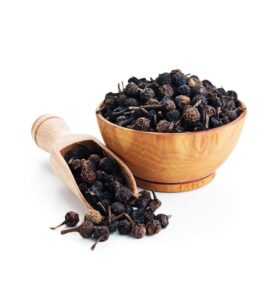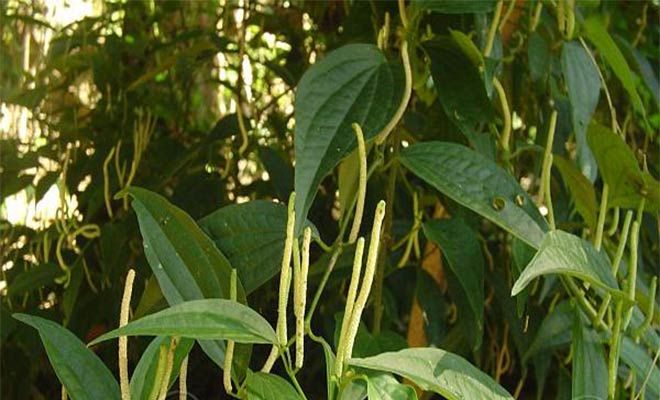Herb
Kankola (Piper cubeba) Herb Ayurvedic Overview
Kankola (Piper cubeba) comprises mature, dried fruits of Piper cubeba Linn. (Fam. Piperaceae). It is a woody, perennial, climbing with dioecious flowers in a spike, cultivated to a small extent in India, especially in the Karnataka state. It is also found in Singapore, Malay, Java, and Sumatra. The fruits are collected when mature but still unripe and carefully dried. The dried pericarp is wrinkled, with the color varying from brown to black.
Kankola is an herb mentioned in Ayurveda for managing cough, indigestion, swelling, erectile dysfunction, and dysmenorrhea. The pharmacological activity of Kankola shows appetizer, aromatic, anti-oxidant, anti-microbial, anti-parasitic, diuretic, anti-inflammatory, gastro-protective, hepato-protective, and nephron-protective properties.
The fruit is essentially used in various Ayurvedic formulations and is attentively sourced and dried to ensure the preservation of the herb. Oil is used in urinary diseases like cystitis, gonorrhea, etc. This herb is beneficial in managing externally swelling and inflammation, increasing sexual wellness, respiratory issues, etc. Mixing it with dental powder can be applied to teeth. It is used in formulations of Haritakyadi rasayana, Khadiradi vati, Jeerakarishtama and in Drakshasava.
Table of Contents
Scientific Classification of Kankola (Piper cubeba):
- Kingdom: Plantae
- Order: Piperales
- Family: Piperaceae
- Genus: Piper
- Species: cubeba
Kankola (Piper cubeba) Synonyms:
- Sanskrit: Kankolaka, Cinosana, Cinatiksna, Kakkola, Kankolika
- Assamese: Kakkol, Kababcheni
- Bengali: Kahabcbini, Sugandhamaricha
- English: Cubebs, Tailed Pepper
- Gujrati: Chanakabab, Chinikabab
- Hindi: Seetalchini, Kababchini
- Kannada: Gandhamenasu, Balamenasu
- Kashmiri: Kushfal, Kababchini
- Malayalam: Cheenamulaku, Takkolam, Valmulaku
- Marathi: Kankol
- Oriya: Kababchini
- Punjabi: Kababchini, Sardchini
- Tamil: Vaalimilaku, Valmilagu
- Telugu: Chalavamiriyalu, Tokamiriyalu
- Urdu: Kababchini
Kankola (Piper cubeba) Description:
 a) Macroscopic: Fruit is wrinkled, cylindrical or rounded, 5 to 7 mm in diameter, grayish brown to dark brown to brownish-black in color, about 7 mm long stalk connected, pericarp red to moderately brown, testa fused with pericarp, fruit hard and stony albumen white and oily, the odor is aromatic end characteristic, taste, pungent and is slightly bitter.
a) Macroscopic: Fruit is wrinkled, cylindrical or rounded, 5 to 7 mm in diameter, grayish brown to dark brown to brownish-black in color, about 7 mm long stalk connected, pericarp red to moderately brown, testa fused with pericarp, fruit hard and stony albumen white and oily, the odor is aromatic end characteristic, taste, pungent and is slightly bitter.
b) Microscopic:Transverse section of fruit manifests outer layers of the epidermis, externally enfolded with thick cuticle; a raw of 2 to 5 small, crushed, brown and thick-walled cells below, mesocarp consists of large, thin-walled parenchymatous cells, oil cells, and vascular bundles. The endocarp of multi-layered sclereids heavily lignified with slender lumen, testa, and tegmen built of elongated cells tegmen cells hyaline and kernel cells greyish in color.
Identity, Purity, and Strength of Kankola (Piper cubeba):
- Foreign matter Not more than 2 percent, Appendix 2.2.2.
- Total Ash Not more than 8 percent, Appendix 2.2.3.
- Acid-insoluble ash Not more than 1 percent, Appendix 2.2.4.
- Alcohol-soluble extractive Not less than 14 percent, Appendix 2.2.6.
- Water-soluble extractive Not less than 11 percent, Appendix 2.2.7.
Chemical Constituents of Kankola (Piper cubeba):
Unripe fruit of this herb contains volatile oil in 10-20% comprises of sesquiterpene hydrocarbons; lignans, largely cubebine about 2%, with kinokinin and cubebinin; cubebic acid. From the fruit of this herb, the oxygenated cyclohexanes, piperenol A and B, with crotepoxide and zeylenol. Cubeb oil is extracted from the fruit, which is slightly greenish and becomes colorless on rectification. The plant also contains Piperine, Cubenin, Sesamin, Hinokinin, Clusin, Dihydrocubebin, Cubebinone, Isoyatein.
Ayurvedic Properties and Action of Kankola (Piper cubeba):
- Rasa: Katu, Tikta
- Guna: Laghu, Tiksna
- Virya: Usna
- Vipaka: Katu
- Karma: Dipana, Kaphavatahara, Pachan, Ruchya, Vastishodhana, Mukhadaurgandhya hara
Ayurvedic Formulation made by Kankola (Piper cubeba):
The primary formulations of Kankolas mentioned in Ayurvedic Pharmacopeia of India and classical textbooks of Ayurveda are Dasamularisa, Kumaryasava, Jeerakarishta, KhadiradiVati, Drakshasava, Pugakhanda, and Haritakyadi Rasayana.
Therapeutic Uses of Kankola (Piper cubeba):
The main indications of Kankola are Sula, Aruci, Mutrakrcchra, Mukharoga, Asyadaurgandhya, Hrudroga, Krumi and Agnimandya. Laghu, Tikshna, Deepana, Pachana, Hrudya, and Ruchiprada properties are explained in classical Ayurvedic textbooks with details.
Dose of Kankola (Piper cubeba):
The recommended dose of Kankola as per classical Ayurvedic text is1-2 g of the drug in powder.
Reference:
Ayurvedic Pharmacopeia of India.
For regular health updates, please follow our Social Pages


